Scottish technology ecosystem: review
Review of the Scottish tech ecosystem by Mark Logan, commissioned by the Scottish Government, with recommendations on how to develop a world-class tech sector.
Chapter 2 – Ecosystem Supporting Categories – Education
It is generally understood that interventions in our ecosystem that create more talent in programming, engineering and adjacent disciplines are essential to increasing the output of our ecosystem. An often overlooked but equally critical point is that the ecosystem also fundamentally depends on access to leadership talent (technical, strategic, and of people) at each stage of the funnel. Without suitably equipped people in sufficient numbers, smaller businesses are unable to successfully scale, even if their products have high potential. Opportunity and investment are squandered. See Appendix A Why Can’t Start-ups Scale? for a deeper illustration of the importance of founder-team education to successfully scaling start-ups. A further key point is that entrepreneurship itself is also teachable.
The outcomes of our ecosystem are therefore heavily dependent on our Education Funnel (we’ll shortly explain why we depict education as a funnel in its own right). The more people our education funnel produces with the above capabilities, the higher will be the output of our ecosystem.

In this section, we’ll first define in detail what we mean by the education funnel. We’ll then examine each stage of the funnel as it currently operates in support of our ecosystem and identify weaknesses and areas for improvement. For each stage, we’ll outline an overall strategic approach for how the funnel could be systematically improved. In the recommendations section at the end of this document, we’ll present consolidated recommendations in this category alongside those in the other supporting categories of the ecosystem (Infrastructure and Funding).
Definition of the Education Funnel
The education funnel can be depicted as follows:
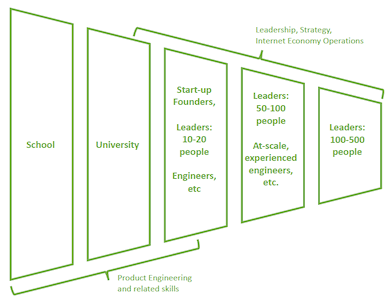
Starting from the left-hand side of the diagram and proceeding towards the right-hand side, we are first concerned with nurturing the foundational skills in software programming at school level. This constitutes much of the engine that will power future tech start-ups. The larger the pool of engaged and skilled young people at this stage, the easier it will be later for start-ups to form and to grow. This focus on raw engineering skills continues as we move to university-level where they are significantly enhanced. At this stage they are joined by rudimentary business and leadership skills. As we move further to the right of the funnel, we come to the needs of early-stage and then later-stage start-ups, and beyond. At these stages of the education funnel, we are more concerned with growing the base of people with skills in Internet Economy business operations, people leadership, technical leadership and technology strategy development.
This emphasis on the Internet Economy version of these skills is extremely important. We use this term to characterise a certain approach to product development and management. It is characterised by an unwavering focus on speed of iteration within a business context, on organisational agility at all levels of scale, on a relentless pursuit of product-market fit, on the application of modern growth engineering techniques such as the exploitation of compounding growth mechanisms, and on a very high degree of data-driven experimentation, to highlight just a few examples. Only if Scottish start-ups and scale-ups embed these working practices within their organisational models can they expect to compete with the Silicon Valley’s best businesses. And they must – the internet age not only brings global customers to our doorstep; it brings global competition too. A key related point is that, because these skills are only sparsely represented within the Scottish ecosystem, they will partly need to be sourced from outside the country by various means.
Returning to the education funnel, we should note here that there are multiple versions of this funnel reflecting the different industries that constitute “tech” (though there is considerable commonality between them, particularly in the later stages of the funnel). So, it’s more accurate to draw the above diagram as follows:
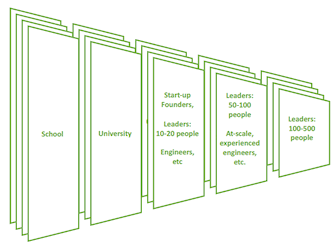
For simplicity, we will depict this funnel in the singular for the remainder of this document and will focus on the funnel specifically rooted in software engineering, as that is the primary focus of this review. It should be borne in mind, however, that there are actually multiple funnels in play, reflecting e.g. pure software businesses, electronic engineering, mechanical engineering, biotech, etc, and that the overall ecosystem model is applicable to all root technology types.
Naturally, just as with the ecosystem itself, the education funnel also narrows from left to right – not every Computing Science student can or should found a start-up, for example. But again, we meet the problem that the funnel’s natural narrowing rate and actual narrowing rate are not the same.
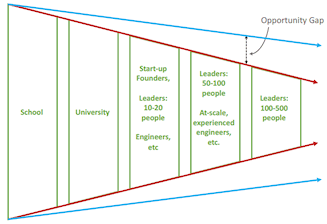
This is because, currently in the Scottish ecosystem, there are areas requiring significant improvement in each of the stages of the education funnel as it relates to the subject of this review[5]. We believe that this situation, probably more than any other factor, undermines Scotland’s capability to produce a steady flow of world-class scaled-up technology businesses.
This is also the major influenceable reason for the imbalance in our tech ecosystem (many small start-ups and very few scale-ups). Without sufficient capacity and capability in the education funnel – particularly in the area of Internet Economy leadership and strategy – the tech ecosystem funnel collapses, as we’ve seen earlier. We just don’t have the knowledge, skills or experience in sufficient volume in our earlier stage start-ups to navigate them to scale.

This is why Education is so important to the Ecosystem. For example, increasing the funding available to start-ups won’t make much difference to outcomes if the competence doesn’t exist within the ecosystem to build businesses that are capable of putting that capital to good use.
Put more positively, the right interventions in the education funnel create the conditions to move the ecosystem funnel through its tipping point. Without pre-empting the recommendations listed later in this document, one illustrative way to explore this point is to ask the question: what effect would it have on our tech ecosystem if universities produced twice as many graduates who were ready, willing and able to form start-ups and run them competently? What changes in university teaching, intra – and extra-curricular activities etc. would bring that change about? This is just one example. We can ask analogous questions of other stages in the education funnel.
Such questions are the starting point in the identification of practical interventions in the education funnel. In the recommendations section of this report, we will propose a comprehensive set of such interventions and support.
Conceptually, these interventions must impact the education funnel in one or more of three ways if they are to be valuable. In summary, they must Reduce the Rate of Narrowing, Widen the Down-Funnel Stages and/or Shorten the Funnel. Let’s now briefly review each of these categories.
1. Reduce the Rate of Narrowing
We are effectively leaking talent between stages of the funnel (hence the over-narrowing as we move through the funnel) and our portfolio of interventions and support should address this loss. Clearly some leakage is natural, but our opportunity is, as before, to reduce the gap from the actual rate towards the natural rate.
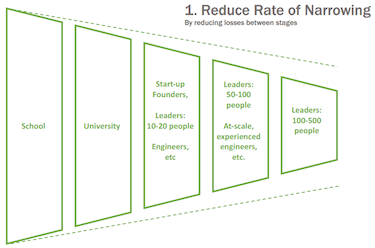
2. Widen the Down-Funnel Stages
Actions in this category attempt to return talent to the pipeline that was lost in earlier stages. Again, without wishing to jump to solutions at this stage and for illustration only, Codeclan is an excellent example of this type of initiative – creating engineers who missed the conventional university degree route into software engineering the first-time round. We could relatively easily support Codeclan to double or more its graduate numbers. Encouraging talent immigration is another example.
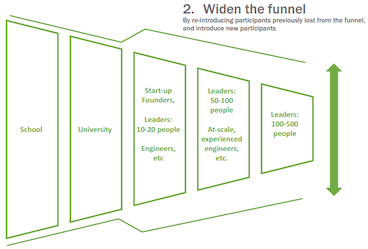
3. Shorten the Funnel
These actions accelerate the experience and knowledge of funnel participants. As an illustrative example, world-class training courses in Silicon Valley start-up growth techniques exist and would be enormously beneficial to our ecosystem. However, these are currently only partially available to some start-ups due to cost and exclusivity reasons. What if all of our start-ups had access to this material through a national license? Another example: we have a large international pool of Scots working in the Silicon Valley and around the world in senior leadership positions. Many would gladly support our emerging young leaders. What if we tapped that diaspora to a much greater extent than we currently do?

As we now begin our analysis of the Education Funnel, starting with the School and University stages, we note that there’s a particularly close relationship between these first two stages; related problems tend to exist in pairs at the interface between these stages. Later interventions to address those problems must take this relationship into account[6].
Stage Analysis – School
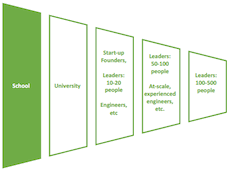
The human capacity to support start-up creation and growth at all later stages of the tech ecosystem is already largely determined by the time our young people leave school. The more of them we equip with programming and related skills at school level, the more start-ups we’ll have later[7].
This principle doesn’t just apply to the supply of future software engineers. It also predicts the number of future founders too. Starting a technology-intensive business requires two things at the outset: an idea and the means to demonstrate that idea. The greater the level of software skills held by the would-be founder, the easier it is to do that.
For example, there’s one principle reason cited by undergraduates studying “non-technical” courses at university and who are interested in starting a business as to why they struggle to do so: they lack the prototyping skills needed to demonstrate or develop their idea. Of course, later in the development of a start-up, non-technical founders may well be in a position to hire specialist programmers to further build out their products, but at the outset they cannot. Business undergraduates, for example, (and those in related disciplines) are amongst the most business-minded of students and produce a relatively high level of start-up ideas. They just can’t test them out.
This mismatch between desire and agency represents a considerable loss of start-up potential. The same principle, of course, applies to those who wish to start a technology-intensive business without following the university route.
So, to recap, the more people we equip at school level with a basic level of competence in Computing Science, the more start-ups we’ll eventually produce and the greater the pool of engineers we’ll have available for those start-ups to hire from as they develop. In a country with a very small population such as ours, this point is of even greater importance.
Against that starting point, our fundamental strategic error as a country is that we don’t treat Computing Science in the same way as we do Mathematics or Physics. For that matter, we don’t treat it with the same importance as History or Geography, for example, either.
| Subject | Intensively taught from stage: | Secondary teachers typically hold relevant degree qualification? |
|---|---|---|
| Mathematics | Primary 1 | Yes |
| History | Late primary/1st year Secondary | Yes |
| Computing Science | 3rd year Secondary (optional) | No |
Below, we examine some of the consequences of that treatment of Computing Science. In the recommendations section, we’ll propose actions to improve our country’s performance in this critical area.
But the summary is: given that this stage in our ecosystem is foundational to all future stages, the present situation is not compatible with our ambitions for Scotland’s technology sector. And the impact is not limited to the tech sector; many sectors of our traditional economy, such as Law and Financial Services, are increasingly being disrupted by Internet Economy business models and techniques. It would be wise to equip our future professionals with a basic grounding in the discipline.
Unfortunately, the situation is deteriorating. Figures from the Scottish Teaching Census and the SQA indicate that the number of Computing Science teachers in our schools is falling[8] as is the number of pupils taking the subject[9].
We need to treat Computing Science seriously, as if it were Mathematics or Physics, if we are genuine in our ambitions to be a competitive technology economy. This must be our direction of travel. It implies that a more-than-incremental approach to the problem will be required.
Gender stereotypes are already in place prior to formal teaching of Computing Science
Before we can influence our children to the contrary (we generally don’t formally teach Computing Science until 3rd year in Secondary school), gender stereotypes have already taken hold. On average, 84% of students studying higher Computing Science are male in any given year[10]. It’s not hard to see the massive loss of talent from our future start-up pipeline brought about by this state of affairs (in addition to the removal of opportunity from girls that it represents).
The syllabus is restricted to what can be taught by non-specialists; it’s boring
In general, Computing Science is not taught by specialists. i.e. Computing Science graduates or those from related technical disciplines. This may perhaps be because such graduates generally have many highly paid career choices open to them. Or it may be because the education system does not actively compete with other employers to hire them into the profession from university.
Within schools, teachers are often co-opted from other disciplines, such as Business Studies, to teach Computing Science. This is perhaps not surprising when we consider that 17% of our secondary schools have no dedicated Computing Science teachers[11].
Our reliance on non-dedicated[12] and non-specialist teachers impacts upon the syllabus, by restricting what can be taught. The interest level inherent in the syllabus, including associated projects, is therefore reduced. Put simply, the curriculum is boring; it is the author’s experience that, anecdotally, many children who profess an interest in Computing Science before commencing National 5 studies are put off the subject during those studies. Approximately only 50% of students who study Computing Science at National 5 level choose the subject at Higher level, compared to 70% for History and Geography, for example[13]. For a subject that is inherently magical (the ability to build almost anything), this is disappointing, and something is wrong.
The subject is not signalled as important to future career opportunities
We formally teach Mathematics and English from Primary 1. We formally teach History, Geography, Physics, Chemistry and Biology from Secondary 1. In contrast, we formally teach Computing Science in Secondary 3, and as an optional subject. This sends signals to children and parents as to the subject’s importance. This state of affairs is not aligned to the needs of our economy. Skills Development Scotland reports that annual vacancies in ICT in Scotland average 13000, with average salaries in the sector 26% higher than the overall average (and rising more quickly).[14]
Lack of support given to voluntary/extra-curricular organisations
There are several national and local programmes supporting extra-curricular programming support for children, including Young Engineers and Science Clubs (YESC), CoderDojo, Code Club, Make it Happen, Prewired, The DataKirk (which supports data literacy for BAME young people), Digital Skills 4 Girls and dressCode (these last two clubs work to mitigate the horrendous under-participation of girls in Computing Science). They are mostly volunteer-led and receive a mixture of public and private funding support.
This area is an excellent example of a point we discussed earlier – that small interventions in the ecosystem can eventually have a profound impact on the performance of the ecosystem as a whole, including by enriching the diversity of the tech sector. However, provision is very patchy, with some areas and age groups under-represented. Most clubs report equipment and staff limitations to scaling their activities. There seems to be an opportunity here to provide more strategic support to this important area at relatively limited cost.
The entry level of students into University Computing Science courses is relatively basic, requiring remedial teaching
Let’s explore this point by analogy: imagine if Mathematics was formally taught only as an option and only from Secondary 3 onwards. At what capability level would a university Mathematics degree programme be required to start from in its 1st year, in consequence? What effect would that, in turn, have on the final knowledge level of our mathematics graduates?
Strategic Framework for Action – School stage
- To address the issues outlined above, the guiding principle to our interventions at this stage of the education funnel must be that Computing Science should be considered as equal to other sciences or mathematics in the school curriculum. Such a treatment has a number of significant implications, in terms of from when and how, by whom and how much the subject is taught in our schools, which we review in our recommendations section.
- In the intervening period and beyond, those voluntary organisations currently providing extra-curricular programming clubs would benefit from a more strategic approach to support, to increase the coverage of programming clubs across Scotland, and across demographics.
- Specific focus must be brought to the acute and chronic gender imbalance in Computing Science at school level. Strategically, we must start from the principle that the situation is unacceptable rather than “normal.”
We’ll make specific proposals based on these strategic principles in the recommendations section of this document.
Stage Analysis – University[15]
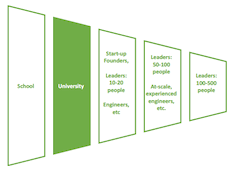
There are three outputs pertinent to the review that should be optimised at this stage of the Education Funnel. The first is the number of graduates who are interested in founding or joining a start-up, and who are equipped with the key start-up skills required to do that. The second is the number of Computing Science graduates (and those from related disciplines) produced by our universities. The third is the rate and viability of spin-outs from our universities. We’ll consider each of these in turn.
Computing Science Graduates Equipped with Necessary Tech Start-up Leadership/Business Skills
Within the scope of this review, we consider this to be the most important of the three outputs at the University stage of the Education Funnel in increasing the subsequent ecosystem start-up success rate. But it currently receives relatively little focus at university level.
Below, we review the main areas where performance could be improved at this stage. There are two summary observations from that analysis that should be addressed in our ecosystem strategy as it relates to the University stage. The first is that there’s a large variation in performance across institutions, with some far ahead of others in their embrace of entrepreneurship across the curriculum and in spin-out and start-up support. The second is that improvements can be made in how even our best institutions approach this problem relative to international best practice. In the discussion points below, we do not wish to embarrass individual institutions and so have expressed our points in general terms.
Let’s begin our analysis by considering what good looks like internationally, and then examine the gap between that and typical practice in Scotland (recognising that there is considerable variation across institutions).
The best universities view industrial collaboration in general, and start-up facilitation in particular, as equally important to their other missions of teaching and research. They understand that it is difficult to be genuinely world-class in teaching and research without being world-class in industrial liaison and entrepreneurial support. With any of these missing the others are diminished.
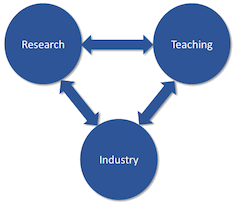
Lets consider Stanford University, in California. It’s worth remembering that the Silicon Valley came into being in the first place largely because of the start-up-friendly, supportive environment created by Stanford in the Valley’s earliest days. More recently, of the 300 private tech companies valued at more than $1 billion in 2019, 63, or one fifth, of their founders studied at Stanford. The university runs 145 courses on entrepreneurialism, including many full-semester courses specifically on high-technology entrepreneurialism, it actively encourages students to explore start-up ideas, gives them facilities to do so and even directly and indirectly invests in student start-ups. In return, multiple benefits flow back to the university from its alumni, including endowments, research grants, world-class speakers and mentors, student placements in alumni businesses, access to cutting edge technology, teaching partly led by top technology industrialists, and brand benefits. In this last regard, it’s difficult to place too high a value on the kudos that flows to Stanford from the fact that Google’s founders started the company there, to name but one example. This attracts further talent and funding.
In contrast, the following issues are more typical of Scotland’s approach:
Little or no incentivisation to encourage an entrepreneurial mindset amongst technical students
University science courses, including Computing Science, are measured on many KPIs, typically none of which include entrepreneurial aspects. For example, there’s no KPI which measures the number of graduates founding or joining a start-up within 12 months of graduating (or similar).
Therefore, no real incentive exists to invest in this type activity.
In fact, existing KPIs risk operating to actively reduce institutional enthusiasm for entrepreneurialism to below its otherwise natural level. Universities are partly measured by the proportion of students who finish courses. If Larry Page[16] had attended a Scottish university, a KPI somewhere would have tipped towards amber when he co-founded Google, then towards red when Sergey Brin joined him. In effect, it is in the local interests of universities to disincentivise entrepreneurial start-up activities, lest students drop out and form start-ups[17]. This is not to say that universities literally operate according to this disincentivising KPI, the point is that there is no funding benefit to the university in doing otherwise (note that we are not suggesting that drop-out rates shouldn’t be tracked or don’t matter, rather that they must be placed in their proper context).
The above is a typical example of the issue of local versus global optimisation within the technology ecosystem, discussed earlier.
A further pertinent issue is that the extra-curricular activities (for example, summer start-up schools) and facilities (such as incubators) required to support entrepreneurial activities are not included in the funding settlement for Computing Science students, or those from related disciplines (c.f. Clinical disciplines, for which analogous lab costs are already accounted).
These root issues lead to consequential problems:
Inadequate staffing to support entrepreneurial activities
Universities employing several thousand people have, in some cases, as few as two FTEs dedicated to supporting student entrepreneurialism. Again, this figure varies considerably according to the attitudes of respective institutions towards entrepreneurialism. But, on average, it contrasts poorly with best practice elsewhere.
Limited incubation space for student start-ups
The general question of incubation facilities will be discussed in Ecosystem Supporting Categories – Infrastructure shortly. Here, we are referring to incubation space for students, recent graduates and post-graduates to experiment with early start-up ideas.
The provision of incubation varies considerably across our major universities, with some providing excellent facilities and some, despite running multiple Computing Science and engineering courses, having no such facilities.
Computing Science (and related) courses have little tech start-up leadership teaching content
To prepare and engage students in graduating to start-ups after university, Computing Science and related courses should feature, at least to an elective level, the following or similar content, in addition to, or partly as an alternative to, the existing, strongly technical syllabus:
Core-curricular
- Internet-Economy best practice in product introduction and growth engineering.
- Fundamentals of internet-economy business operations.
- Case studies of multiple well-known tech start-ups and scale-ups, both successful and unsuccessful.
Cross-curricular
- Inter-school/faculty collaboration projects (for example, Business, Computing Science, Engineering, Design schools), start-up simulation exercises.
In practice, this tends not to be the case or is provided to a minimal level (the less interested an institution is in entrepreneurialism, the worse the problem is likely to be).[18] This problem is exacerbated by the squeeze incurred by the remedial teaching time required by universities to bring first year students to a common basic level of knowledge about Computing Science, which we discussed above.
Therefore, Computing Science students tend to graduate with very strong technical knowledge but very little knowledge of how to take a product to market, per the Silicon Valley start-up “playbook”. The consequences of these gaps are two-fold. Firstly, many students don’t feel equipped to consider start-ups as a career option (or are not even aware that this is indeed an option). Secondly, students who, as undergraduates, attempt to form a start-up are usually ignorant as to how to do so and make basic mistakes leading to avoidable failure. This results in disillusionment, which tends to turn students away from this career option and towards more established, “safer” businesses.
Business and technical students tend to be taught apart
To illustrate this particular point, consider the following pathology. Computing Science students know how to build software but frequently lack business acumen or awareness. Business students often brim with start-up ideas but lack the means to build software. If they were brought together frequently, it is likely that start-ups would emerge from these combined skillsets and, at the very least, everyone would learn useful techniques for later business life. But these two groups usually move in separate circles; they are taught separately, and their core-curricular projects are separate.
There are bright spots; for example, in one of our universities, students across all subjects are introduced to entrepreneurship within the curriculum and encouraged to interact with students from other disciplines in entrepreneurial projects. In another of our institutions there is an annual weekend “collider” event, where students from different schools in the university take part in a cross-disciplinary start-up competition. But, overall, we are a long way from the regular co-mingling of knowledge and mindsets required here across all of our institutions.
We discuss, in Ecosystem Supporting Categories – Infrastructure, the need for our start-ups to have access to social infrastructure, those “market squares” where people can meet, physically or virtually, to exchange ideas, learn from each other and collaborate across specialisms and domains. The same requirement exists at university level, and universities are particularly well-placed to fulfil this need for their students. However, this tends not to happen because individual schools within a university tend to operate largely independently of each other and are largely occupied with their own KPIs. The consequence of this is to reduce the start-up learning experience for students and to reduce the number of student start-ups.
Little to no support for funding student start-ups
Best practice institutions such as Stanford have facilities to support student and early post-graduate start-up activity through limited seed-funding mechanisms. Such funding mechanisms bridge the gap for start-ups prior to being ready to seek funding from other routes, while they develop their early ideas. Such facilities are not generally available across Scotland’s institutions.
Provision of start-up summer schools is limited
Some universities run excellent start-up summer schools for students and recent graduates. In these, students form start-ups and work to build a real product or service. During the summer, they receive advice and training on a variety of product and business areas. These programmes are particularly valuable because they provide real-world experience to consolidate, supplement and enhance knowledge gained during the academic year. We consider these to be a best practice element of a university education as regards the scope of this review. A similar scheme, Converge, operates in support of recent university spin-outs.
However, the provision of such programmes across our universities is patchy. There are two possibilities here, which are not mutually exclusive. One is for more/all of our universities to adopt the summer-school approach. Another is for Scotland, nationally, to adopt the successful tranzfuser initiative from the UK Games Talent and Finance CIC. This is a UK-wide summer school for games software graduate student start-ups, resulting in a funding prize and accelerator programme for the best companies. Such an approach could be generalised and applied across Scotland.
Provision of summer internships at tech start-ups is limited
Summer internships are an excellent means by which students gain business and commercial experience during their studies. Universities provide some support to students looking for internships while the Saltire Scholars Programme, organised by Entrepreneurial Scotland, placed 181 students internationally in 2019. For those students wishing to take up an internship, the main barriers to doing so are the availability of internships domestically – especially in tech start-ups – and the availability, cost and difficulty of accessing international internships. Initiatives to increase the supply of internships to Computing Science students, and those from related disciplines, should be actively examined. We make specific suggestions in this regard, in the Recommendations section of this report.
Locally resident Computing Science graduates (and related disciplines) produced by our universities
The second output from the University stage of the Education Funnel concerns the number of software engineers (and related disciplines) produced by our universities. Scotland has a very small population, which in turn affects the number of software engineers that it can produce to satisfy the needs of a growing and improving ecosystem. Although not the only means by which software engineers can enter our tech ecosystem, the university route is nevertheless the main source of supply. It’s therefore important that we maximise the number of software engineers graduating from the university system who can then reside and work in Scotland for the long-term. But it is anticipated that, from 2021, we will experience a supply-side shock due to a likely collapse in participation by EU students as a result of Brexit.
An influenceable constraint in this category is the number of Scottish students gaining access to Computing Science and related degree programmes in Scotland. This level is heavily influenced by the relative value of Scottish students, in funding terms, compared to far more lucrative overseas students (who generally return to their home countries[19]). It would be unfortunate if improvements in the School stage of the Education funnel were not matched by an increase in capacity at the University level to accommodate them. If it is a strategic imperative of government to increase the supply of engineering talent into the tech ecosystem in Scotland, then an appropriate financial settlement and KPI model should be reached with the university system in Scotland in support of that goal.
Number and Viability of University Spin-outs
The third output from this funnel stage is the number of viable spin-outs produced. It would be easy to be complacent about Scotland’s spin-out performance; the country has the highest spin-out rate outside of London. But, in this category, it’s important to consider both the rate and viability together of university spin-outs. Scotland’s spin-out rate is heavily bolstered by relatively high levels of government investment but there are few success stories, in terms of businesses that have grown to scale or exited at high valuations. Rate and viability must be considered, and improved, together.
Universities report that activities related to licensing and spin-out creation are expensive and are usually regarded as a cost base rather than an income stream[20]. This likely acts as a disincentive to invest effort in this area, though we note here that our institutions vary very widely in their enthusiasm and support for spin-out activity.
Our view is that focus should be brought to bear on the income part of that equation rather than the cost part; by increasing the general success rate of spin-outs, the cost issue will resolve itself. In this regard, several factors act to reduce both the rate of spin-outs and their viability. These should be addressed in our strategic response.
Equity stakes too high/too rigid
Equity stakes taken by universities in spin-outs are often too high; up to 50% in some cases. By comparison, at Stanford the average is 10%, at Massachusetts Institute of Technology (MIT), 5%[21]. This level of equity acts as a disincentive both to founders and investors and makes follow-on investment more difficult to obtain. Later potential investors are wary to invest where they see that founder stakes are already heavily diluted. Their concern is that such dilution retards the motivation of founders in what is an extremely demanding personal journey. This issue is amplified by the fact that university spin-outs generally require more funding than other start-ups to reach a minimum viable product (because they are typically attempting to exploit technologies which are relatively new and unproven). So, founder dilution is likely to be more severe than would otherwise be the case.
It is, of course, reasonable for a university to expect an equity stake in a business that has been nurtured by the university, through its research, expertise and facilities. But this stake must be practically workable in the world outside of the institution. Compare with Stanford and Imperial College London (ICL), for example, which both take a flexible approach in this area, for example, by varying equity stakes based on the specific level of pre-incubation and follow-on support provided to the fledgling start-up.
Lack of start-up business acumen amongst academics
It’s generally accepted that academics tend not to make the best CEOs over the lifetime of a company (or even at the start in many instances); the skills required bear little resemblance to those required in academia. This has a direct bearing on the likely success rate of spin-outs, subsequently. There are three problem areas which should be addressed.
The first is that some universities implement articles for spin-out companies that significantly reduce their chances of success because they make it very difficult for a founding CEO to be moved to another position later, or exited by a board, as the company develops, without their express agreement. This reduces the company’s credibility as an investment opportunity too.
The second problem is that universities frequently do not place enough of a requirement on a potential spin-out to recruit seasoned start-up executives as part of the spin-out process. Of course, such people need not be permanent employees of the spin-out, they can occupy mentoring positions, for example.
The third area for improvement is that universities could do more to equip spin-out founders themselves with the modern start-up skillset that we discussed earlier in this document as pertaining to students. This has a direct bearing on the later success of those spin-outs. This is a slightly difficult point to implement in practice because ego often comes into play and because the spin-out academic founder may underestimate the importance of start-up technique. At any rate, its rarely a pre-requisite for spin-out support, currently. One way of implementing this requirement, and which doesn’t require direct support from universities, is to place emerging spin-outs into the Tech-Scaler network initially, where founders could then benefit from the education programme operating there. We develop the Tech-Scaler concept in the Infrastructure section of this document.
Strategic Framework for Action – University stage
To address the issues outlined above, we believe that the following strategic principles should apply:
University policy is naturally influenced by the financial settlement between the sector and government. Therefore, the KPIs and associated financial incentives governing university funding should be adjusted such that:
- start-up entrepreneurial and internet-economy techniques are embedded into Computing Science and engineering courses, with institutions incentivised to include the attributes discussed above in those programmes.
- universities produce more software engineers.
- universities produce more – and more viable – spin-outs, with institutions incentivised to include the attributes discussed above in those initiatives.
It should be acknowledged that to achieve this focus, other KPIs will likely have to be adjusted. Simply adding more KPIs to any organisation only dilutes focus.
It should also be recognised that much of our discussion above adds up to an additional tax on universities to support Computing Science students. Today, extra-curricular activities, incubators, summer schools, etc., are not included in the funding settlement for Computing Science students. Compare with Clinical disciplines, where the need for provision beyond basic teaching is already recognised. A similar settlement model could be used for Computing Science and its related disciplines. Costs could be managed by sharing capabilities and programmes across universities, similar to the Research Pool model already employed to bring scale and efficiency to certain research programmes.
Stage Analysis – Early-Stage Leadership, Engineers, etc.
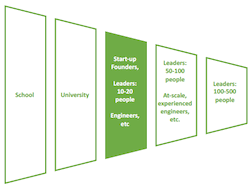
It’s difficult to overstate the importance of this stage of the pipeline to the successful scaling-up of our start-ups. Of all the stages in this Education Funnel, improvements at this stage have the most immediate positive impact on the likely success of our current early-stage start-ups and later scale-ups, and therefore generate the fastest returns on interventions made, as well as on-going returns at every later stage of company scale.
There are two distinct categories at this stage of the education funnel. In this section we’ll first define what we mean by early-stage leadership in more detail and analyse the ecosystem’s performance in delivering that education, highlighting a number of areas for improvement. We’ll then consider how to further increase the supply of engineering talent at this stage of the pipeline (i.e. post the formal university-education stage).
Finally, we’ll develop a strategic framework for interventions in this area. Specific recommendations based on this framework are put forward in the Recommendations section of this review.
Definition of Early-Stage Leadership
Early-stage start-up leadership skills refer to the following categories (with illustrations in parentheses):
- Silicon Valley business models (for example, network effects, platforms, growth models and techniques, compounding growth mechanisms, commercial models and techniques, etc.)
- Internet-Economy working practices (lean start-up techniques, speed of iteration, experimentation, bottleneck constraint analysis, etc.).
- Fundamentals of team and people management (for example, staff development, communications, performance management, conflict management etc.).
- Fundamentals of funding models (for example, explanation of investment stages and terms, building relationships with VCs, pitching skills, alternatives to venture funding, etc.).
- Basic operating hygiene (including legal compliance, IP management and HR sufficiency).
The degree to which a start-up’s founders and early leadership team have proficiency in the above skills determines the degree to which investor capital and time are effectively spent (or wasted).
There are three ways to inculcate these skills; through experience, through education or both. Of course, the last of these is most preferable. But since Scotland’s ecosystem is currently short on experience, we must go long on education.
By education, we mean here structured education. In so saying, we recognise that a lot of good business education is gained through what we term in this review market square[22] activities, those interactions between founders, experienced executives etc. that happen in meet-ups, conferences, in the lunch areas of incubators and so on. These are undoubtedly very valuable; but although they are necessary, they are insufficient. Formal grounding in the above fundamentals is also required.
Analysis of the Provision of Early-Stage Leadership Skills
Against these requirements, we now assess Scotland’s ecosystem in this area. There are three related areas of concern:
Fundamental internet economy start-up skillset is not present in the majority of our start-ups
To re-state the root issue, not enough of our founders and early-stage start-up leadership teams have the above skillset. This reflects the pre-tipping point, relatively immature state of our tech ecosystem. There is a general lack of experience in the ecosystem. In a post-tipping point ecosystem experience and best practice circulate between businesses as experienced employees move between them. In our ecosystem this happens to a much lesser extent. We must therefore mitigate that lack of experience by more intensive education in the areas listed above. We must not be complacent on this point; Scotland’s tech start-ups are competing internationally (the internet effectively reduces the distance to all markets to zero, but all international competitors benefit in the same way). We therefore have no choice but to operate to international best practice in order to compete.
Ecosystem too internally focussed, not learning enough from outside
The consequences of the above point are that inexperienced executives tend to educate each other, in our various market squares (accelerators, incubators, conferences and meet-ups). This sets a relatively low ceiling on skills in our ecosystem. To overcome this, it’s important that we turn the eco-system outwards to learn from international best practice. What this means in practice is that, in addition to formal education (covered in the next point) our various start-ups, our conferences and even meet-ups need to, as much as possible, have access to international expertise.
Not enough formal education taking place at start-up level, in incubators and accelerators
Most of the education done in accelerators and incubators is somewhat informal and ad-hoc. The same is true, of course, of conferences and the like. It tends to take the form of presentations and Q&As with successful practitioners. This is valuable, necessary even, but it is not sufficent. Recognising our pre-tipping point status as an ecosystem, structured, intensive education to start-ups in the disciplines listed above is required. We’ll discuss how this might be delivered in Ecosystem Supporting Categories – Infrastructure, later in this document.
Increasing the number of engineers at this stage of the pipeline
In addition to the leadership skills discussed above, our start-ups and scale-ups also need a steady supply of engineering talent. As we’ve seen, the ecosystem tends to “leak talent” during its earlier stages (for example, children who didn’t develop their interest in Computing Science at school level and who might have done in other circumstances). This creates an impetus to complement the supply of engineers coming through the traditional educational route with other options. Essentially, we are “widening the funnel” by creating these additional supply routes.
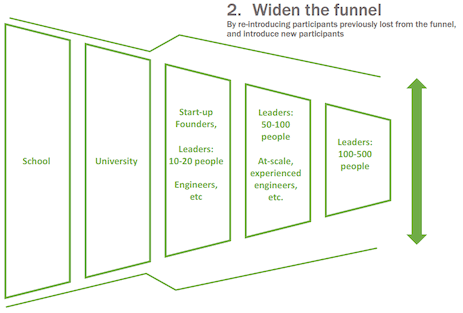
Scotland has already established Codeclan, an organisation that provides a 16-week intensive training programme in software engineering from bases in Edinburgh, Glasgow and the Highlands. When compared to comparable college-level courses, Codeclan significantly outperforms. Completion rates are higher, employers are enthusiastic and engaged with the organisation and are starting to compete to employ its graduates. Students tend to be changing careers into software engineering, with more life-experience than typical students, which makes them particularly interesting for industry[23]. The gender balance of graduates is better than is typical it is in software engineering courses.
The courses cost circa £6000, though there are some loan and grant options available to help students meet these costs.
We believe that Codeclan is an excellent mechanism for widening the funnel at this point, bringing a new supply of life-experienced and motivated students into the ecosystem. This resource is not currently being treated sufficiently and strategically as a key “funnel-widener.” We should significantly scale Codeclan, so that far more graduates can be produced and we should scale the access funding paths for prospective students.
We should also examine how Codeclan’s approach could be replicated to some extent throughout our colleges.
Strategic Framework for Action – Early-stage Leadership, Engineering, etc.
To address the issues outlined above, we believe that the following strategic principles should apply:
- Our ecosystem needs to instantiate an appropriate platform where the following skillsets can be routinely taught at the required scale to our start-ups as they move through the early start-up stages: Silicon Valley business models, Internet Economy operating practices, fundamentals of team and people management, funding models and business hygiene. Where appropriate, these materials should be sourced from best-in-class international training resources (such as Reforge.com, for Silicon Valley business models, for example) and national licenses negotiated where possible.
- Access to learning from world-class practitioners, invited to participate in our ecosystem through various forums should be facilitated and supported. In essence, we need to turn our market square outwards, to learn from the best. This is with particular reference to our conferences.
- Our international diaspora should be tapped more actively as a strategic resource following. For example, Ireland’s successful model where a comprehensive, coordinated and long-term diaspora strategy was created at the outset of activities in this area. Our diaspora includes executives placed in many of the world’s most admired technology companies. Diaspora networks exist today in the form of SE’s Global Scot and the independent SBN. We should examine how to leverage and scale these resources more effectively under the umbrella of an ambitious exploitation strategy. We also note that many “exiled Scots” return to Scotland later in their careers, representing a potentially valuable seam of experience that should be more actively tapped where possible.
- We should encourage our large number of self-organised tech meet-ups by giving them access to free meeting space and resources.
- We should provide funding support to our successful “funnel-wideners” and treat them as a strategic asset to be carefully scaled. Best practice “funnel-wideners” such as Codeclan, should be studied as to how their success can be replicated in our colleges, to the extent that it is transferable.
Stage Analysis – Mid-to-Late-Stage Leadership
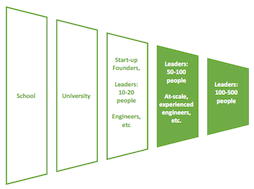
These organisations have similar requirements to earlier stage businesses but are additionally concerned with operating these skills at much higher levels of scale. Being larger, they are generally more capable of addressing their own needs in many of the areas that are challenging for smaller start-ups but there are still issues to be addressed.
Very difficult to attract senior executive tech talent to Scotland
Earlier, we discussed how difficult it is to bring senior, experienced leaders and senior individual contributors such as senior engineers to Scotland from, for example, London and the Silicon Valley. In summary, this is due to the pre-tipping point nature of our ecosystem and the sparseness of alternative opportunities for an executive if the job for which he/she originally relocated doesn’t work out (which is common at this level of seniority). Without those alternatives, they won’t relocate their families, so they don’t come to Scotland.
Contributing further to this issue, such executives and engineers are expensive for the local market and most of our scale-ups struggle to meet compensation expectations.
Access to this talent and experience is absolutely necessary for our start-ups to continue to scale beyond a certain point. Of course, our local leaders can develop into such people. But, in general, they are currently too few to support the further scaling needs of our scale-ups. This will remain the case until our ecosystem passes its tipping point, at which point sufficient experience is generated by the ecosystem on its own, and external, experienced executives are spontaneously attracted to work within it.
In the meantime, the consequences of this constraint are that, beyond a certain level of scale, our scale-ups either stop growing or they open offices in London to attract executive talent. Those executives then start to hire around them. Within a few years, most of the job creation in the growing company is happening outside of Scotland. This pathology is not limited to Scotland, of course, and affects many of the smaller tech ecosystems.
Strategic Framework for Action – Later-stage Leadership, Engineering, etc.
Until the ecosystem tipping point is reached, novel solutions must be explored to mitigate this issue. We’ll make corresponding proposals in the recommendations section of this review. These proposals are based on a strategy involving risk reduction to candidate executives and cost reduction for early-stage scale-ups.
Contact
Email: loganreview@gov.scot
There is a problem
Thanks for your feedback